Young photographers’ vision on display
March 10, 2011
 This weekend, the Venice Arts Gallery hosts an opening reception for a new photography exhibit called “Picturing Health,” showcasing more than 50 compelling images captured by young photographers throughout Southern and Central California. Their work reveals more than a bit of tarnish on the Golden State, documenting the community impacts of gang violence, poor nutrition and inadequate health care.
This weekend, the Venice Arts Gallery hosts an opening reception for a new photography exhibit called “Picturing Health,” showcasing more than 50 compelling images captured by young photographers throughout Southern and Central California. Their work reveals more than a bit of tarnish on the Golden State, documenting the community impacts of gang violence, poor nutrition and inadequate health care.
This project was funded by the California Endowment through the Building Healthy Communities initiative, with faith in the power of photojournalism to help expose and correct inequity and injustice in our society.
The reception takes place Saturday from 5 to 8 p.m. at the Venice Arts Gallery, 1702 Lincoln Blvd. in Venice. The exhibit runs from March 12 through April 30. For further information, call (310) 392-0846 or email inquiries to [email protected].
Posted 3/10/11
Beach’s elder statesman looks back
March 10, 2011
 Edward Craig remembers waves so oil-polluted that he couldn’t swim without washing himself afterward with turpentine. He remembers beach crowds so environmentally careless that they blithely dumped their trash right onto the sand.
Edward Craig remembers waves so oil-polluted that he couldn’t swim without washing himself afterward with turpentine. He remembers beach crowds so environmentally careless that they blithely dumped their trash right onto the sand.
He remembers when surfers waxed their longboards with the paraffin their mothers used for canning. He remembers when women’s tank suits turned to bikinis and bikinis turned to thongs.
But ask the 70-year-old how many lives he has saved as Los Angeles County’s longest continuously serving lifeguard, and memory fails him. “Oh, my gosh,” he says. “Thousands.” Which makes sense, since Craig has been watching over local beach-goers every summer, without exception, for more than 50 years.
A retired teacher who for 38 years taught music in the Anaheim Union High School District, and who still supervises student teachers at Biola University, Craig has had a second career lifeguarding on weekends and summers since his late teens. County employment records show he was hired in May 1959 and has worked every summer since, including last summer. (One other recurrent lifeguard is older and has an earlier hire date, but records indicate that a medical issue sidelined him last year.)
“I’ve always liked the water,” says Craig, who grew up in Lennox and bicycled as a child down Imperial Boulevard to the ocean. “Riding on the waves as a body surfer, the ocean throwing you toward shore.”
Craig played water polo at Inglewood High School, El Camino College and Cal State Long Beach, and spent his childhood swimming and surfing in the South Bay. His favorite beach as a young man, he says, was the popular Manhattan Beach surf hangout known as El Porto; located near the Chevron oil refinery in El Segundo, its signature attraction is underwater—a deep fissure in the bay floor known as Redondo Canyon, which generates bigger-than-average waves on a consistent basis.
It also generates bigger-than-average crowds and bigger-than-average risks for swimmers—downsides that Craig would learn more about when, at 19, he became an ocean lifeguard. El Porto, which is still where he works most, ended up being his first professional post.
“On my first day on the job, I had 37 rescues,” Craig remembers. “People losing their boards, people stepping into rips. It was a pretty rough day.”
Does he remember the first swimmer he saved? “No,” he says, “but I do remember some amazing rescues over the years.”
There were the two exhausted swimmers he pushed for the length of three football fields on a surfboard to free them from a particularly vicious riptide.
There were the seven kids from Lawndale who ran full-tilt into the ocean, even though they could not swim and Craig had warned them to stay out of the water.
“I had two on the can, one by the hair, one in a cross-chest carry, one holding onto my foot, ” he remembers. “I was out there by myself—all the other guards were involved in other calls that day. Fortunately an older surfer came by and took the other two off my hands.”
Then there was the yellow Labrador who chased a stick into a riptide, leaving his anguished master ankle-deep in water, shouting the dog’s name helplessly at the waves. “The dog was way out there and really struggling—I could just see his nose barely sticking out of the ocean,” Craig remembers.
“I started swimming, wondering how in the world I was going to do this rescue. But when I swam up and I shoved my rescue can under his belly, he put his paws through the front handholds and they got stuck! I was able to drag him to shore, and the guy was so grateful, he came back to the tower with a case of beer the next day.”
Craig was glad, too: “I kept thinking, ‘What if I have to give this dog mouth-to-mouth?’”
Craig says the county’s beaches have changed substantially over the summers. For one thing, they are much cleaner and safer than they used to be.
“There was a lot more pollution. We’d often take a gallon of turpentine along to wash ourselves off after swimming. We’d paint each other down with a big paintbrush—you didn’t want to track that oil through your mom’s house. Also there was a lot of litter—you could look all up and down the beach and not see a trash can. And there was a lot more tar on the beach.”
Now, government regulation and environmental consciousness deter litterbugs and industrial polluters. “The beaches are meticulously cleaned,” Craig says. “We have four trash cans every hundred yards.”
And beach-goers are safer. Lifeguards are more professional, more numerous, better trained and stationed in lifeguard towers that are better equipped and closer together.
“Back in the ’60s, rescues were much longer distance because people would be pulled out farther,” Craig remembers. “Not because ocean conditions were different, but because there were so many fewer of us that by the time we got to them, they could be 50 yards offshore in a big boil. And there were no wave runners to help us out.”
Nor, for many years, was there much law enforcement, at least at El Porto. When Craig started, the beach was an unincorporated “county island” between Manhattan Beach and El Segundo. Packed end-to-end with little surf shacks arrayed along narrow alleys, El Porto was notorious in those early days for the bevies of airline stewardesses who bunked there and the surfers who populated its raucous bar scene. Until Manhattan Beach annexed the 34-acre area in 1980, the nearest authorities were 20 minutes inland at the sheriff’s Lennox substation, he says.
“We had one period in the mid-1970s where a group of armed Nazi surfers declared it their turf,” Craig remembers. “They’d throw things at people from the parking lot and shoot holes into the back of the lifeguard towers.” If someone at the beach was injured, he says, the paramedics of first resort were the lifeguards. Now, of course, El Porto is just another well-patrolled coastal neighborhood in sedate, pricey Manhattan Beach.
One thing that hasn’t changed much is the exceptional fitness required of county ocean lifeguards. Craig still vividly remembers his first lifeguard certification test.
“You swam around a buoy at the Hermosa Pier, and then south to the breakwater, then around another buoy and then back to the beach,” he recalls. “You did this in mid-April, so the water was still quite cold. It was a thousand-yard swim, not counting the 200 yards out and the 200 yards back in, and there were over 200 people, probably, the year I took the test.
“They took the top 25 across the line. I saw the mob going for the buoy and I thought, ‘Oh, my God.’ I was a decent swimmer, but it was daunting. The water was so cold, and the current so strong, and the wind so fierce that almost half the people had to be picked up or brought back in before they covered the first 200 yards.”
But Craig made it: “I was No. 11,” he remembers. “These things stick in your mind. “
Craig still takes the test every year, and still passes. “Obviously I’m not the fastest guy on the beach, but my average time is about 10 minutes, 30 seconds, depending on conditions,” he says.
His fitness regimen is not the average 70-year-old man’s daily workout. A 30-mile bike ride every Monday. An 80-lap swim on Tuesday, Thursday and Saturday. Two-miles of wind sprints on the beach, twice weekly. A 3-to-5-mile row in a single-man Dory twice monthly. On-duty workouts daily. Oh, and he still surfs two or three times a month.
“He’s the perfect waterman—an elder statesman of lifeguarding,” says Section Chief Terry Yamamoto of the County Fire Department’s lifeguard division, who has known Craig for three decades, since Yamamoto was a teenager hanging out at El Porto and Craig was the summer lifeguard there. Craig, he says, was one of a handful of lifeguards who mentored him into the profession. Among other things, Yamamoto says, Craig taught him “how to stay calm in all situations.”
“The older you get, the wiser you get in this job,” says Yamamoto. “You can almost predict how people are going to behave on the beach. It becomes instinctual, so that you can be where you need to be almost before something happens.
“We’ve been on literally hundreds of rescues together, and because he’s been on the job for so long, Ed tends to be there as quickly as the younger guys because he knows where he’s going to be needed.”
Nonetheless, Craig says, “this year will probably be my last.”
“I’ve never lost a swimmer,” he says, “and I still feel I could make any rescue I could see. But I’m getting to the point now where you try to be realistic about your career.”
Retiring from the lifeguard tower would give him more time for his music, his wife of 46 years and his two granddaughters; it might also make for some slightly less stressful summers. “Ninety percent of the job is sheer boredom and ten percent is sheer terror,” jokes Craig.
Still, he says, “I don’t think I’ll ever get tired of watching the water—the pelicans flying by, the surf, the sailboats, the ships offloading their supplies. It never changes, and yet it’s always different, always moving. It’s one of the fascinating things about the sea.”

El Porto Lifeguard Station
Posted 2/16/11
Masters of ceremony
March 9, 2011
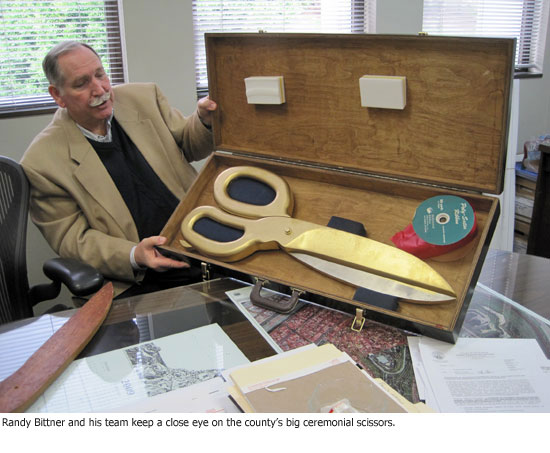 Every time a Los Angeles County dignitary grins into the camera and cuts a big red ribbon, somewhere up there Arthur “Ski” Wisniewski is smiling, too.
Every time a Los Angeles County dignitary grins into the camera and cuts a big red ribbon, somewhere up there Arthur “Ski” Wisniewski is smiling, too.
Back in the early ’80s, Wisniewski, a carpenter and manager in the Internal Services Division, ushered in the county’s modern era of ceremonial snipping when he handcrafted a pair of immense solid wood scissors with sharp metal blades that actually cut.
Of the five original pairs (one for each supervisorial district), only two remain in service. They’re closely guarded implements, ferried to events in custom-crafted cases and quickly packed away once the TV cameras have gone home.
“We have to more or less guard them now,” says Randy Bittner, ISD’s section manager for facilities operations services, who keeps the scissors locked up when they’re not in use. “The guys never take their eyes off them.”
“The guys” are ISD’s special events section—the backstage crew for virtually every public event staged by a county supervisor or department anywhere in L.A. County.
If ceremonial events provide a symbolic narrative of government work in action, these guys are the story’s unsung ghost writers.
They work out of a hangar in East Los Angeles equipped with a carpentry room and well-stocked with folding chairs, tables, lattice backdrops, tents, gold-painted shovels (for groundbreakings) and even a couple of ice machines.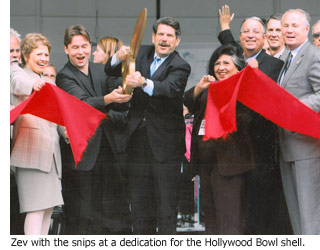
You get the feeling that, given a cake and a deejay, these guys could stage a pretty good wedding reception if they had to. It hasn’t come to that, but they have set up events ranging from hospital wing openings and park gymnasium groundbreakings to postage stamp unveilings and supervisorial trail rides. They created an impromptu “green room” for Seal when he performed at the county’s Rancho Los Amigos National Rehabilitation Center. Their carpentry work ranges from ADA-accessible walkways to those oak podiums featuring the county seal, regularly seen at press conferences on the nightly news.
“We see our programs on television all the time. I tell my wife, ‘I built that,’ ” says Sylvester “Sly” Anthony, the team’s carpenter supervisor.
As for the scissors, the ISD team oversees a dry run before each event to make sure the ceremonial cut takes place without a hitch. (The advice is always the same: Make sure the ribbon is pulled taut.)
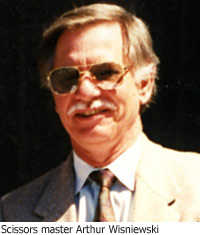 Even though the scissors are as tall as a toddler, they are surprisingly easy to use. Despite being pressed into service at hundreds of events over the years, they’ve held their edge without any special maintenance.
Even though the scissors are as tall as a toddler, they are surprisingly easy to use. Despite being pressed into service at hundreds of events over the years, they’ve held their edge without any special maintenance.
“It’s not like trimming hedges,” Bittner says.
In recent years, they’ve helped to inaugurate projects big and small, including the new County-USC Medical Center, the new emergency room at Olive View-UCLA Medical Center, the Department of Public Social Services’ mobile food stamp sign-up van and a fitness zone at El Cariso Park in Sylmar.
By all accounts, creating the scissors was Wisniewski’s idea.
“I believe he took it upon himself. He just wanted a better, more impressive pair of scissors,” says Paul English, ISD’s division manager of craft operations.
Wisniewski’s decision to equip his creation with a working blade automatically elevated them above the props widely used elsewhere—the ones that look good for the cameras but can’t shear through even the flimsiest ribbon.
“Most of them don’t cut,” English says. “I’ve never seen one with an edge.”
Wisniewski got to see his scissors in plenty of action before he retired in 1997 after 35 years of county service. He died last year, but his scissors remain on active duty—as sharp as ever.
“We like ‘em,” English says. “They’re visually impressive.”
Sowing the seeds of smart gardening
March 9, 2011
 For a dozen years, Curtis Thomsen has crisscrossed Los Angeles County, preaching the gospel of gardening.
For a dozen years, Curtis Thomsen has crisscrossed Los Angeles County, preaching the gospel of gardening.
Don’t throw away yard waste, he exhorts. Composting can reduce water consumption by up to 50% per household. And don’t forget the lowly earthworm.
“Worm tea is the strongest organic fertilizer there is,” he likes to say.
Thomsen, an environmental consultant and master gardener based in Cerritos, has conducted the Countywide Smart Gardening initiative for the Los Angeles County Department of Public Works since 1998. Launched 20 years ago as a way to reduce the amount of yard waste being sent to landfills, the program has grown to encompass not only green-waste recycling, but a range of assistance on the creation and maintenance of sustainable landscapes.
The county now operates nine demonstration and learning centers where visitors can learn—for free—about sustainable agriculture, native plants, water conservation and organic gardening. As a bonus, Thomsen’s weekend workshops offer subsidized compost and worm bins for $40 and $65, respectively—a healthy 60% discount.
Countywide Smart Gardening information stands have been installed in parks, schools, community gardens and nature centers. The program’s experts will make presentations at the L.A. County Fair in September and host a booth at the Natural History Museum next month as part of its “Sustainable Sundays” program on “edible landscapes.”
Public Works’ Smart Gardening Program Manager David Perez says the program has educated thousands of Southern Californians, who have been increasingly driven toward home gardening by concerns about the environment and sustainability.
“We do free workshops where the public can learn about composting, where they can see native plants and native gardens, where they can get a feel for the process,” says Perez. And one of the most popular features (besides the discounted composting apparatus) is Thomsen’s no-cost advice.
“I come from an agricultural background—we’ve done composting since I was about 5,” says Thomsen, who was born in San Gabriel and raised on farms in Oregon and Idaho. Thomsen earned bachelors degrees at Oregon State in business administration and statistics, with a special emphasis in agriculture.
 He returned to Southern California in the early 1990s to get his certifications in solid and hazardous waste management at UCLA, just as municipalities were working to comply with a then-new law requiring cities and counties to halve the waste they were sending to landfills. Thomsen and his brother, Keith, who holds a Ph.D. from UCLA in environmental science, began working with engineering consultants to help local governments set up composting facilities and recycling programs before the law’s 2000 deadline.
He returned to Southern California in the early 1990s to get his certifications in solid and hazardous waste management at UCLA, just as municipalities were working to comply with a then-new law requiring cities and counties to halve the waste they were sending to landfills. Thomsen and his brother, Keith, who holds a Ph.D. from UCLA in environmental science, began working with engineering consultants to help local governments set up composting facilities and recycling programs before the law’s 2000 deadline.
That expertise, he says, led to the creation of their own environmental consulting firm, BioContractors, Inc., through which Thomsen—with contract oversight from Public Works’ Perez—now runs Countywide Smart Gardening. Thomsen and his crew do 50 workshops a year at the learning centers, plus another 35 or so hosted offsite presentations that are co-sponsored by church groups, nonprofits and other municipalities. Spring is crunch time; between Earth Day observations and demand for spring planting information, his calendar is typically booked solid.
“Right now we’re at 31 events scheduled for April alone,” he says.
“The big push we like to do is vermi-composting because it has so much benefit to the environment,” Thomsen says. That’s composting with worms. Thomsen’s favorites are Eisenia fetida (also known as African Red Worms or Red Wigglers). Bred to thrive in the debris layer of jungle topsoil, they can process massive amounts of organic matter quickly, eating and excreting 80% to 100% of their body weight each day in food waste.
Besides aerating the soil, Thomsen says, they produce manure, or castings, that can be mixed with potting soil to create a high-nitrogen bioactive fertilizer. And, he says, the liquid from those castings—a substance called ‘worm tea’—can be diluted to create a systemic fertilizer, or used straight to kill gnats, aphids, white flies and most weeds.
Thomsen tells his audiences that even regular backyard composting can dramatically improve their garden yield—and make a crucial environmental difference. “The average person in L.A. County generates about a ton of garbage a year,” he says. “Forty percent of that is compostable.”
That’s 800 pounds of table scraps and grass clippings per year per person that could and should be fertilizing yards in L.A. County, “instead of going into a landfill.”
Is composting smelly? “No,” he says. “If you do it right, there should be no odor.”
Is it time-consuming? “No. About three minutes to put the bag of material in the bin and stir. You add water on a weekly basis.”
Does he compost at his house?
Here he laughs. Turns out Thomsen used to, but his current landlords, in Bellflower, are—for now—non-believers in his gospel.
“They won’t let me put in a composter, so I take all my stuff to the office. I have four worm bins there.”
Here is a video introduction to Backyard Composting, brought to you by L.A. County’s Countywide Smart Gardening program.

Posted 3/9/11
Erasing “wire blight” in Topanga
March 8, 2011
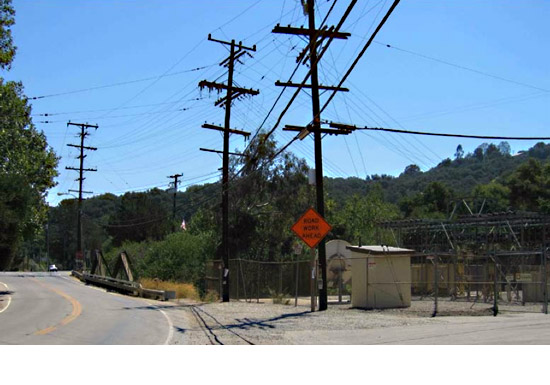
It isn’t the sexiest construction project in Los Angeles County. And it won’t be finished until 2014.
But to anyone acquainted with the hazards of fire season—or just the hazards of trying to find an unobstructed view in pretty-but-populous Southern California—the plans taking shape this month in Topanga eventually should offer a whole new perspective.
Next week, the county Department of Public Works and Southern California Edison representatives will launch a series of meetings to discuss the undergrounding of overhead utility lines in the rural community’s central business district around Topanga Canyon Boulevard and Old Topanga Canyon Road.
The $2.4 million project, which will be paid for by a statewide utility fee administered by Southern California Edison in L.A. County, will bury about a third of a mile’s worth of electricity, cable and phone lines that now clutter the view and present ongoing traffic and fire hazards along the right-of-way.
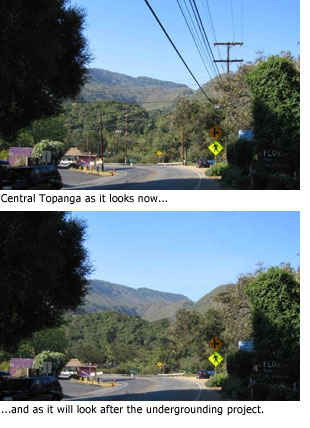 “The main goal is aesthetic, but there’s also a safety issue,” says Steve Dunn, a senior civil engineer at Public Works. Power poles along winding roads, such as Topanga’s, raise the risk of motor vehicle crashes. And in recent years, at least three massive Southern California brushfires have erupted as tree limbs and lashing utility lines have been blown into overhead power conductors by Santa Ana winds elsewhere in the region.
“The main goal is aesthetic, but there’s also a safety issue,” says Steve Dunn, a senior civil engineer at Public Works. Power poles along winding roads, such as Topanga’s, raise the risk of motor vehicle crashes. And in recent years, at least three massive Southern California brushfires have erupted as tree limbs and lashing utility lines have been blown into overhead power conductors by Santa Ana winds elsewhere in the region.
The project is one of many funded by the California Public Utility Commission’s so-called “Rule 20” program, which combats “wire blight” by helping communities and municipalities bury utility lines. Rule 20 regulates a utility’s recovery of the costs of undergrounding overhead electric equipment and gives local governments dibs on a share of a power company’s capital budget according to the number of rate-payers in each jurisdiction.
The annual amounts are not large—the average cost of an undergrounding project only adds about a nickel a month to the average residential customer’s electric bill, according to SCE—but over time, a municipality’s share can accumulate.
Unincorporated Los Angeles County’s allotment, for instance, amounts to about $3 million annually, which the County then splits among its five supervisorial districts.
The Topanga project will be funded by nearly two decades’ worth of the Third Supervisorial District’s allotment.
Other recent projects include a $4 million undergrounding project in an unincorporated area near Arcadia and a $10 million undergrounding and reconstruction project along 2.6 miles of Rosemead Boulevard.
This month’s meeting, Dunn says, will acquaint the community with the project and launch the environmental documentation. (And notify Topangans, incidentally, that construction is expected to take about 1½ years once it breaks ground in 2013.) The gathering is scheduled for 7 p.m. at the Topanga Elementary Charter School Auditorium.
Posted 3/8/11
This is how the county rolls
March 6, 2011
 Back in September, the Department of Public Social Services began fighting hunger where it lives by using a mobile unit to help people sign up for food assistance. During the the next few weeks, it’ll be headed into Hollywood and the San Fernando Valley.
Back in September, the Department of Public Social Services began fighting hunger where it lives by using a mobile unit to help people sign up for food assistance. During the the next few weeks, it’ll be headed into Hollywood and the San Fernando Valley.
The Health and Nutrition Mobile Services Unit essentially is a traveling DPSS office, complete with computers and staffers to help with paperwork. Its mission is a crucial one, especially in these challenging economic times.
Only about half of eligible county households currently are enrolled in the CalFresh program, formerly known as food stamps. This means government funds are going untapped and families are going without help to meet their basic nutritional requirements.
The Mobile Services Unit has begun to make a dent in the disparity. It has distributed more than 700 applications, with 430 of them being returned as of last week.
Although its primary work is to bring CalFresh to those who need it, the unit also will offer other services, including help with Medicaid applications. Various community groups are providing the venues for the DPSS truck and supplying their own services.
This month, the Health and Nutrition Mobile Services Unit will be in the Third District at three locations. They are:
Friday, April, 8, from 9 a.m. to 2 p.m.
Los Angeles City College – Mini Resource Event
4311 Melrose Ave., Los Angeles, 90029
Wednesday, April 20 from 9 a.m. to 2 p.m.
Van Nuys Worksource Center – La Mission College
11623 Glenoaks Blvd., Pacoima, 91331
Saturday, April 30 from 9 a.m. to 1 p.m.
Canoga Park Farmers Market & Community Health Fair – at the Community Center
7428 Owensmouth Ave., Canoga Park, 91303
Posted 4/6/11
Art opening at the Schindler House
March 3, 2011
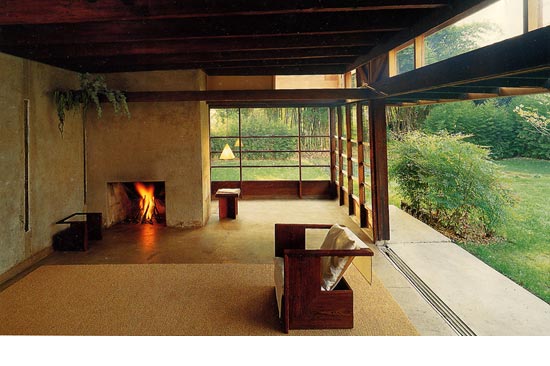
Art and early 20th century modern architecture harmonize in the MAK Center’s Schindler Lab, Round One. This installation exhibit features three-dimensional works by artist Olivia Booth and architect Thurman Grant, who unite to highlight the world-famous Schindler House, an archetypal Modernist dwelling designed by R.M. Schindler.
Sara Daleiden and Kimberli Myer of the MAK Center developed the project and helped the artists install the works while protecting the 1922 structure. Artists Booth and Grant spent regular time cultivating genuine love for the house before using their skills to build exhibits that complement and interpret the original vision of Schindler. Colored glass and mirrored structures are used to double the appearance of the space and draw attention to the physical “rhythm” of the house. Booth described the endeavor:
“My own experience of the Schindler house at King’s Road, after years of visiting it, has been of self reflection; so part of my installation comes down to how a house itself self-reflects, and in turn acts as a reflecting chamber for those who move through it.”
Schindler Lab, Round One opens Saturday, March 5, with a free reception from 3 to 5 p.m. Dancer/choreographer Nancy Sandercock will interact with the art in a special performance. The installation, the first in a series that pairs artists with the house, will remain open to the public during normal museum hours until April 24. Normal admission is $7 per day for adults, $6 per day for students and seniors, and free for children under the age of 12.
The Schindler House is located at 835 N. Kings Road in West Hollywood. Plan your trip with Metro, or drive there yourself. Parking is available at the public structure at the northeast corner of Kings Road and Santa Monica Boulevard.
Posted 3/3/11
Battle of the baristas in Hollywood
March 3, 2011

Coffee connoisseurs can watch the most skilled baristas in the Southwest compete this weekend for a chance to go to the 2011 U.S. Barista Championship.
The Southwest Regional Barista Competition hosts 40 competitors from seven states, who will pull their best espressos Friday and Saturday for a chance to be one of six finalists Sunday who are invited to compete nationally. Each barista has 15 minutes to prepare and serve three coffee courses to a panel of judges. They will be scored based on procedure, consistency, cleanliness, technical expertise, and, of course, taste.
All of the slots to participate this year have been filled, but 1,600 spectators (twice as many as last year) are expected to attend the event, which is sponsored by The Coffee Bean & Tea Leaf. Free coffee will be available to all at the brew bar, and gourmet food trucks including Buttermilk Truck, Manila Machine, Hungry Nomad and Sweets Truck will be on hand to sell their creations. A food truck schedule is available on the website so you can be first in line when your favorite arrives.
The competition will run from 11 a.m. to 5 p.m. on Friday and Saturday. The final round opens at 10:30 a.m. on Sunday, and awards will be given from 1:30 to 2 p.m. Check the full schedule of events for details. The event will be held indoors at Siren Studios, 6063 W. Sunset Ave., Hollywood. Parking will be available in an adjacent lot, but is limited. The event is just a short walk from the Hollywood/Vine station of Metro’s Red Line, so you may want to plan to arrive by subway.
Free after parties with live music will be announced at the competition if you want to continue the celebration after the grinding has stopped. The after parties benefit MusiCares, which provides assistance and resources to musicians in times of need or crisis.
If you want to see what to expect from a top-flight barista, watch this video of World Barista Champion Tim Varney describing the craft.
Posted 3/3/11
A sharp U-turn on Mulholland
March 3, 2011
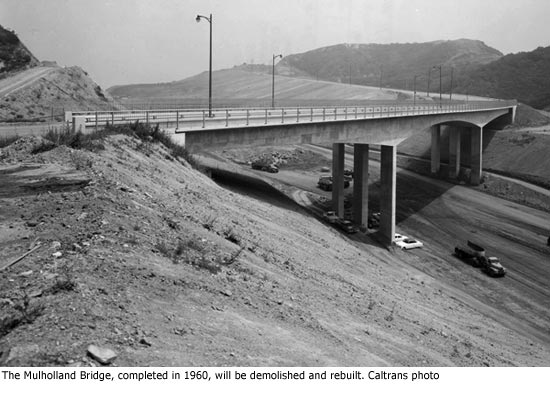
In the end, it was a bridge too far.
A short-lived plan to build a new Mulholland Bridge before tearing down the existing one as part of the I-405 Sepulveda Pass project has been scrapped, less than six months after it was announced to cheers from many in the project’s Community Advisory Committee. Project officials instead are reverting to their original plan of demolishing and rebuilding the existing bridge in two stages—although that’s expected to be costlier and more disruptive to traffic.
It’s also expected to take longer. Mike Barbour, who’s heading up the project for Metro, says that even though the freeway project as a whole remains on track to largely finish by May or June, 2013, the about-face will likely delay the Mulholland Bridge’s reopening for up to three months.
The change of plans comes after a Los Angeles city design review board weighed in on the project, asking for modifications and pushing Metro to go back to the drawing board to create an “extraordinary,” visually striking redesign of the bridge.
At the same time, the Brentwood Residents Coalition filed a series of objections to the project, arguing that the new-bridge plan would hurt the Mulholland corridor’s scenic quality and violate the California Environmental Quality Act if it went forward without a comprehensive environmental review. Letters expressing concern also came from the Bel Air Skycrest Property Owners Association and the Santa Monica Mountains Conservancy.
Their concerns included fears that the new configuration would interfere with the wildlife corridor around the bridge and break up Mulholland Drive by creating a “T-intersection” at the bridge, chopping the road into two segments.
The creation of an all-new Mulholland Bridge would break “the sinuous, continuous line of the beautiful and historic mother road,” Lois Becker, president of the Bel Air Skycrest group, wrote in a letter to the city’s Mulholland Scenic Parkway Specific Plan Design Review Board.
Toni Lewis, an architect on the design review board, said members had not set out to block the new-bridge plan and had made reasonable recommendations to Metro that could have been worked through.
The look of the proposed new bridge, developed in consultation with the project’s Community Advisory Committee, had been intended to mimic the existing structure, completed in 1960. But Lewis said too little consideration had been given to designing something better to befit one of the city’s landmark roadways.
“This is something that’s important and we’re treating it like the overpass at Overland, which it’s not,” she said. “I just thought that it was a total missed opportunity to leave something [the city] could be proud of.”
Metro said the design panel’s recommendations, along with concerns that it might be sued by the residents’ coalition, prompted it to reverse course rather than confront potential delays in court and in the design process.
“Unfortunately, we don’t have the luxury of time,” Yvette Rapose, Metro’s community relations manager for the project, said in a Feb. 25 letter to interested parties. Her letter said the agency was doing so even though it was confident that it had been on “firm legal ground” and would have prevailed in a court fight.
The $1.034 billion project is a Metro-Caltrans collaboration to add a 10-mile northbound carpool lane to the 405, along with other improvements. As part of the design-build process, Metro has been regularly meeting with the project’s Community Advisory Committee, made up of representatives from residents’ groups in the surrounding areas.
The idea of minimizing disruption by building a new Mulholland Bridge before knocking down the old one grew out of a meeting with community members last summer, and was supported by many on the advisory committee, particularly those from Encino and Sherman Oaks.
“I think it’s unfortunate that the best solution didn’t come out of the process,” said Barbour, who’d previously estimated that the new-bridge approach on Mulholland could have saved from $4 million to $10 million. He said the majority of the project’s advisory committee members had favored the construction of a new bridge. “A lot of people were supportive. They just weren’t as vocal as the people who were non-supportive.”
“The long and the short of it is: here we are back at square one,” said Laurie Kelson, a member of the Community Advisory Committee, as well as vice president of the Encino Neighborhood Council and chair of its traffic and transportation committee. Kelson had supported the idea of building a new bridge before tearing down the old as a better way to ensure good emergency response times in the heavily-traveled area and to lessen the overall traffic impact of construction.
She said the process should have given more weight to the opinions of those who live closest to the affected area. “There’s something wrong with the process,” she said. Community representatives from “each segment of this project should really be making the more important decisions about their segment.”
Since the challenge to the new-bridge plan also came from within the Community Advisory Committee, there have been some tensions within the group. But nobody seems to feel that any bridges have been permanently burned. “Did I wish they never started this? Absolutely,” Kelson said, of the committee’s dissenters to the plan. “But certainly there are a lot of good people to work with.”
Wendy-Sue Rosen, a member of the Community Advisory Committee and also president of the Brentwood Residents Coalition, which challenged the new-bridge plan, predicted that the advisory committee would be able to put the differences of opinion behind them.
“We are all strong advocates and disagreement is part of the process. But we pull together when necessary for a common goal,” Rosen said in an e-mail. “I don’t think that the differences of opinion over the Mulholland Bridge will make it harder to work collaboratively with each other or with Metro to ensure the project moves forward in the least disruptive manner.”
Posted 3/3/11




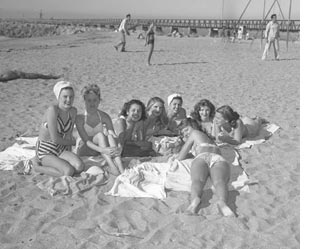

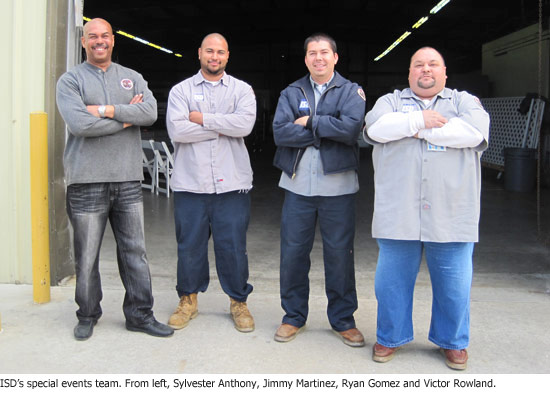





 Check for the latest closure information
Check for the latest closure information








